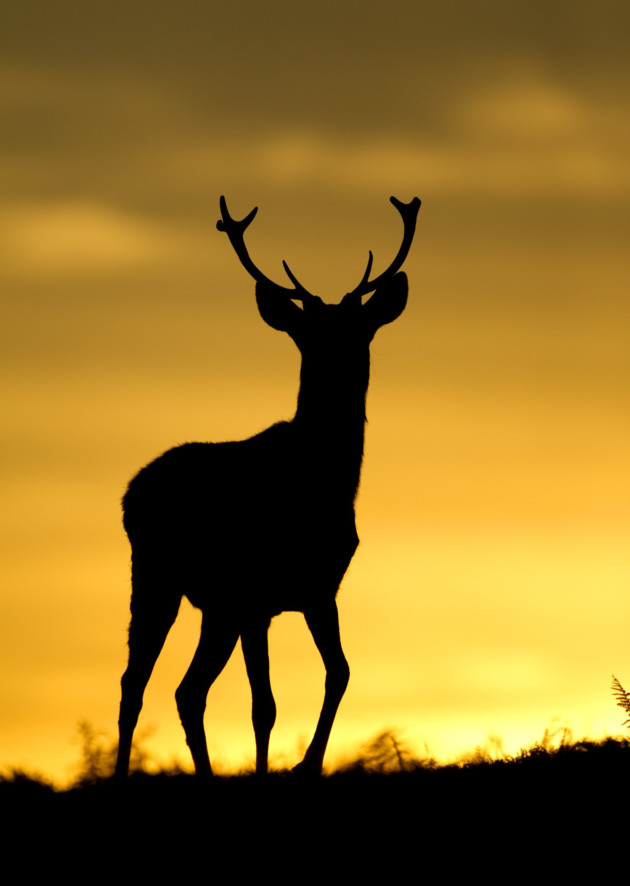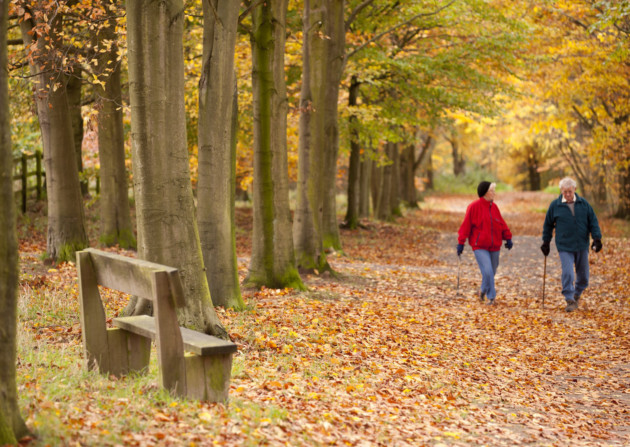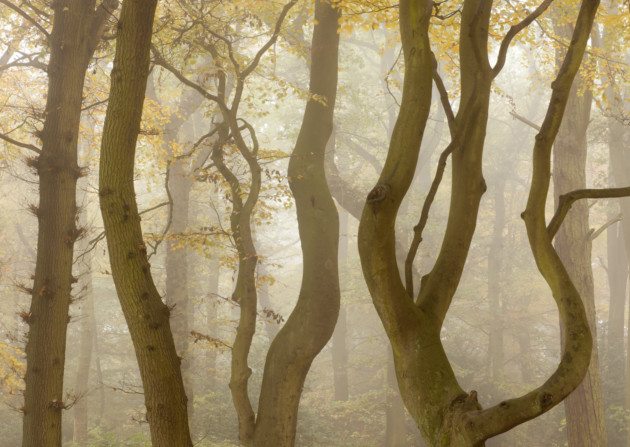Swish your way through the autumn leaves in the beautiful National Forest, in England’s heartland
Paul Bloomfield
What is a forest for? An unusual question, granted – but an important one. Is it a resource to be exploited, a natural wonder to be conserved, a recreational venue?

Red deer stag on a ridge at dusk, Bradgate Park, Leicestershire. Photo: Danny Green
The ambitious National Forest project aims to provide answers as it re-greens a 200-square-mile swathe of England’s Midlands.

Watch out for wildlife in the National Forest. Photo Luke Massey
Tracing the background and progress of the project over the past two decades is a fascinating lesson in how we interact with our environment, and the heritage of the region. Pre-Industrial England, contrary to romantic notions, wasn’t a sylvan wonderland blanketed with wizened oaks. Already, 3,000 years ago, Bronze Age farmers had probably cleared vast tracts, and by the Norman Conquest, most woods had gone – the Domesday Book records tree cover in England at just 15 per cent. Deforestation continued, particularly during periods of war and urban expansion since Tudor times; demand for timber was driven by charcoal burning, shipbuilding, construction and even book production.

A walk along an avenue of beech trees among fallen leaves, Beacon Hill Country Park, Leicestershire. Photo: ROSS HODDINOTT
The Industrial Revolution saw coal-mining and quarrying transform the landscape, notably in northern England. By the start of the 20th century, Britain’s tree cover had dropped to 5 per cent, recovering to 12 per cent by the new millennium. In the Midlands, though, it remained much lower. With the closure of coalmines and related industries, the region became depressed, economically and environmentally.

Autumnal colour and mist, Beacon Hill Country Park, Leicestershire. Photo: ROSS HODDINOTT
Then came the idea, launched in the late 1980s by the Countryside Commission, for a new multi-purpose forest in the heart of England. The area chosen linked the ancient forests of Charnwood, in northern Leicestershire, and Needwood, in eastern Staffordshire, seeding neglected spaces in between. The first tree was planted in 1990, and in 1995 the National Forest Company, a not-for-profit organisation charged with managing the project, was established.
“The three strands running through the project are, in no particular order, social, economic and environmental,” explains Catherine Graham-Harrison, Chair of the National Forest Company. “Of course, these are all interlinked. If we nurture the environment for wildlife we also provide a better quality of life for humans. And by helping to improve the conditions for more work – developing tourism and woodland industries, and attracting businesses – communities and individuals will prosper.”
Clearly, creating a forest is not simply a case of buying 200 square miles of land and planting acorns or saplings. More than 200,000 people live within the Forest’s boundaries, and it encompasses many farmland and industrial sites.
The landscape is astonishingly diverse, too. Yes, there are stereotypically wooded hills such as those in the old Needwood and Charnwood forests, but also floodplains of the Trent and Mease Rivers, patchwork arable fields, heath and parkland, and of course areas of brownfield and industrial wasteground. The mantra ‘the right woods in the right place’, embedded in The National Forest’s philosophy, translates into a range of strategies for expanding tree cover. The company and its partners have taken on forlorn sites and planted species appropriate to each location. Take Sence Valley Forest Park; 20 years ago it was barren, a casualty of opencast coalmining. Since then, nearly 100,000 trees planted in 1998 – mostly Corsican pine, larch and poplar – have softened into a landscaped habitat surrounding waterways where swans, coots, ducks and other birds dabble. Elsewhere, funding is provided to farmers and landowners as an incentive for reforestation, while individuals can sponsor the planting of a tree.
Measuring the project’s success is another conundrum: a forest is never ‘finished’. In simple terms, the goal is to achieve a modern take on the medieval forest, with woods and open land covering up to one-third of the 200 square miles. The woodland and associated habitat will be “sufficiently dense to create a meaningful perception of ‘forest’, without trees dominating the landscape or masking the character of the region,” explains Catherine Graham-Harrison.
By that yardstick, progress has been impressive. In 1990 tree cover languished at 6 per cent; today it’s nearly 20 per cent, with more than eight million saplings planted. Already, young trees are knitting together to become coherent groves and woods.
Established woodlands are flourishing, too: come late April, spots such as Yoxall Lodge, Spring Wood and Ulverscroft are carpeted indigo with native bluebells while lavish displays of snowdrops lure visitors to Dimminsdale Nature Reserve. Ancient oaks in Bradgate Park and, notably, the grounds of Calke Abbey endure centuries after germinating as acorns; the Old Man of Calke is believed to be a veteran of 1,200 years.
It’s not just trees and more trees. Over the past 12 years, over 21 square miles of new woodlands, grasslands, heathland and other habitats have been created, along with scores of wildlife ponds and some 60 miles of hedgerows.
This regeneration of the natural landscape is already having an impact on the area’s wildlife. “Rough grassland that grows around newly planted trees is great for skylarks and short-eared owls, which can be seen around Hicks Lodge many winters,” reports Peter Williams, former Head of Environmental Management for Leicestershire.
The emphasis is on habitat recovery rather than targeting individual animals and plants, but priority species such as the endangered black poplar, lesser spotted woodpecker, ruddy darter dragonfly, and – particularly – otter are enjoying a boost. Two decades ago otters were, if not completely absent from the Midlands, so rare as to be negligible. Today they are back at sites including Sence Valley Forest Park and the confluence of the rivers Trent and Tame at the National Memorial Arboretum.
The region’s human population – and a swell of visitors – are also encouraged to explore and enjoy the environment. Already, there’s public access to more than 200 woods, nearly 80 per cent of the forested area, a figure due to rise to 85 per cent.
There’s a strong emphasis on activities such as walking – not least through the development of a new long-distance trail. Cycling, too, is on the up; dedicated centres at Rosliston Forestry Centre and Hicks Lodge offer a variety of trails, and over 100km of new cycleways have been created. There’s even a National Forest 10K running race.
“For local people, the Forest is a quotidian resource,” says Rob Penn, presenter of the BBC series Tales From The Wild Wood and an advocate of the project, “somewhere to walk and play and breathe. Access to woodlands is fundamental – perhaps more fundamental now than at any time in our recorded history.”
Appreciation of the region’s heritage is also integral. Calke Abbey, an 18th-century National-Trust-owned mansion near Melbourne, is a case in point. With peeling walls and an air of abandonment, it represents a snapshot of the state of many country houses last century – too expensive to maintain, too precious to lose. The combined experience of wandering its crumbling rooms and corridors, then visiting its wildlife-rich parkland, is emblematic of the intended knitting of human and natural heritage.
It’s the same at Bradgate Park, where several hundred red and fallow deer graze rolling heath and woodland surrounding the ruins of the house where, in 1537, would-be monarch Lady Jane Grey was born.
The project also embraces the recent past. Snibston Discovery Museum in Coalville, for example, is an interactive celebration of technology and industry based around a colliery that closed three decades ago; you can tour the pit’s workings, then minutes later be pond-dipping for minibeasts in the country park.
Similarly, Sharpe’s Pottery Museum at Swadlincote proudly incorporates a 19th-century kiln chimney, while a craft village has developed around the old blast furnace at Moira. These are reminders not of some ‘bad old days’ of the mining era, but of the activities through which local communities were seeded and cemented.
Some of those lost industries may be replaced with new businesses involved in the management of the maturing trees. “The National Forest has stimulated the woodland economy at a time when it had shrunk to a pale imitation of what it was 60 years ago,” affirms Rob Penn, “and has created opportunities and awareness of the native timber industry.”
Traditional grass-roots activities are also re-emerging. Peter Wood runs Greenwood Days, providing courses in pole-lathe turning, willow-weaving and furniture-making at his impossibly sylvan workshop in Spring Wood. He settled here around the time the National Forest took root, and has seen crafts grow along with the trees. “It’s getting quite arty here,” he muses, “with more and more craftspeople working around the region. In my village alone there’s a cabinet maker, a pine worker and two blacksmiths, and the annual Wood Fair at Beacon Hill Country Park now attracts more than 5,000 people every year.”
That burgeoning crafts scene surely has an emotional and economic connection to the evolution of the National Forest. And perhaps it’s the best indicator that, even before those newly planted trees are full-grown, the project is already successful. It’s an examplar of what a modern greenwood should be – not merely a collection of trees, but a forest of ideas and aspirations.
To plan your visit to the National Forest, go to www.nationalforest.org/visit




